Despite its reputation for being a staid banking and financial center, Zurich has a beautiful setting on the banks of both a river and a lake, with the Swiss Alps in the background. Its historic core features medieval buildings along cobblestoned streets, picturesque riverside pathways graced by enticing shops and restaurants, and churches and museums to stir your passions and excite your imagination.
I visited Zurich as part of a longer multi-week trip through Switzerland and Austria but was glad to have spent several days at the beginning of my trip here in the capital, as there’s lots to enjoy and explore. I remember arriving early from the train station and walking into Old Town to my pension, situated upstairs over a local restaurant with flower boxes on the window and the sounds of the cathedral’s bell tolling the hours through my open window. This was my introduction to Switzerland. Zurich is a convenient entry or exit point for international flights that make it easy to start or end your trip here.
I love Old Town, the medieval core of the city. Strolling through its cobblestoned streets past medieval buildings and churches whose towers and steeples punctuate the sky makes for a fascinating adventure. But Zurich is a blend of old and new, nowhere better expressed than if you venture out into the Zurich West neighborhood to see how the city has beautifully reclaimed an industrial section of the city that had been full of urban blight.
There are a trio of noteworthy churches in Old Town to explore. Zurich was one of the centers of the Reformation of the Catholic Church, and a visit to the Grossmünster and its Reformation Museum is an interesting introduction to this aspect of the city’s history. The Fraumünsterhas some gorgeous stained-glass windows by Marc Chagall that are must-sees on your Old Town excursions. And the Church of St. Peter has the largest clock face in all of Europe!
Zurich is a cultural center and its artistic roots run deep. Dadaism was founded here and its Museum of Art boasts of an impressive collection of both Swiss and internationally famous artists. Museums abound, from the encyclopedic Swiss National Museum to more specialized collections like the Rietberg Museum and Clock Museum. Check out architectural highlights such as the Le Corbusier Pavilion and the Zurich Opera House.
Get outdoors in this beautiful setting to take walks along the Limmat River or on the Lake Promenade on the banks of Lake Zurich or join in with the joggers or picnickers. Take a boat cruise on the lake or the river, go swimming in warmer weather at one of the free bathing establishments or take a short journey by train to Uetliberg for an exhilarating hike in the mountains. Wander through lovely natural surroundings at the Zurich Botanical Gardens or the Chinese Garden.
Food alone is a reason to come. Sample Swiss specialties such as fondue, raclette, schnitzel and sausages in historic restaurants and cafes. Visit the Lindt Home of Chocolate to marvel at the chocolate fountain, learn about the history of chocolate and see how it’s made. Enjoy a beer garden scenically set out along the river. Shoppers will find fertile territory to make purchases, whether it’s in the elegant shops along Bahnhofstrasse in Old Town or in Zurich West at the Im Viadukt shops in boutiques tucked away under the old railway arches.
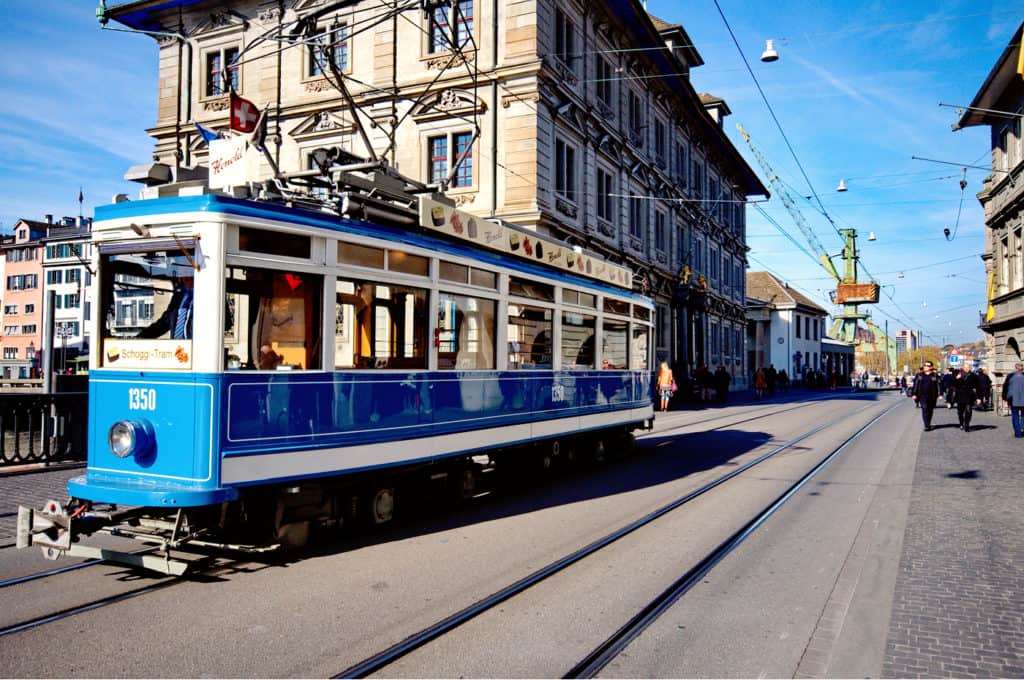
Getting around Zurich
You’ll enjoy walking around the historic heart of Old Town, but Zurich is Switzerland’s largest city, so having access to its public transportation will come in handy if you want to venture out to visit the Uetliberg or perhaps the Lindt Home of Chocolate Museum.
The Zurich Card offers 24 or 72 hours’ free or discounted admission to many museums, provides for a Lake Zurich or Limmat River cruise, a discount on old town walking tours plus unlimited 2nd class access to the trams, buses, trains, boats and cable ways of the city. A 24-hour card costs 27 CHF; a 72-hour card costs 53 CHF.
Top Sites and Experiences in Zurich
Active Outdoor Pursuits
Despite the abundance of cultural attractions like museums and churches, the gorgeous setting of the city will draw you outdoors to experience the natural beauty of Zurich, from its lake and river to the surrounding maintains. Here are some of the best things to do to get outside!
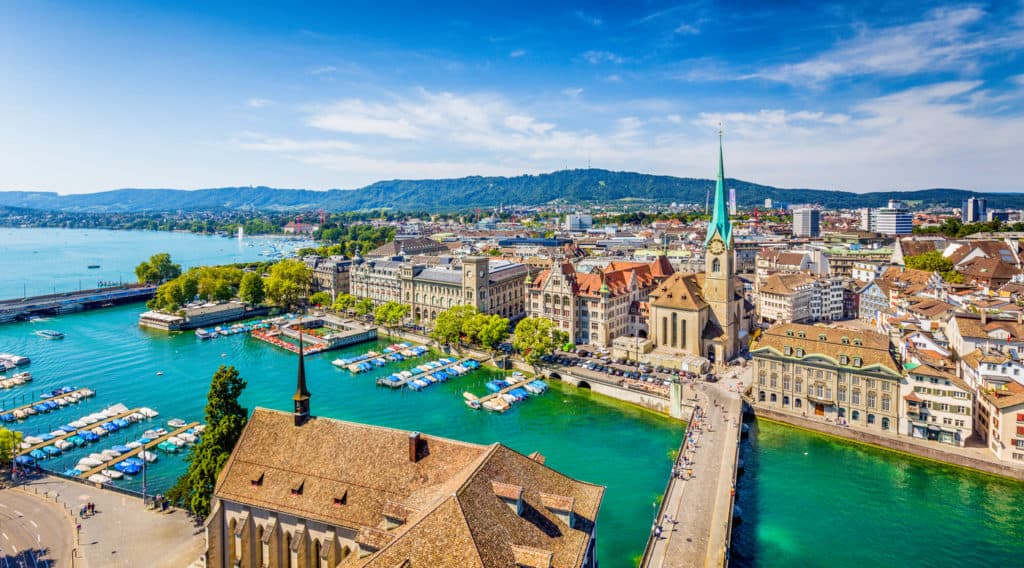
Enjoying Lake Zurich
Lake Zurich provides a wonderful recreational area for locals and visitors alike. Whether it’s a simple stroll or picnic on its shores, or a more active activity like swimming or kayaking, the lake provides a spectacular setting.
One of the best ways to see the lake is to take a cruise or boat ride. The Lake Zurich Navigation Company (ZSG) operates various steamboats on the lake, and also offers river cruises. The most popular lake cruise is a 90-minute round-trip journey as far as the wine-making village of Erlenbach. This trip is free if you have the Zurich Card. There are various culinary-themed boat trips on offer as well. Check out the company’s event calendar for a full list of specialty cruises. A trip on the water gives you an entirely different perspective on the city and its lakeside houses, parks and gardens and is an entirely relaxing way to enjoy the city’s beautiful setting.
If your visit is planned for springtime, there is the “Sechseläuten” (Spring Festival) held in the fairgrounds directly adjacent to Lake Zurich every spring. During the festival an artificial snowman effigy is burned to bid farewell to winter and welcome summer. Participating in a local festival is a great way to meet locals and better understand the culture and traditions of the country you are visiting. The annual Christmas market also takes place here.
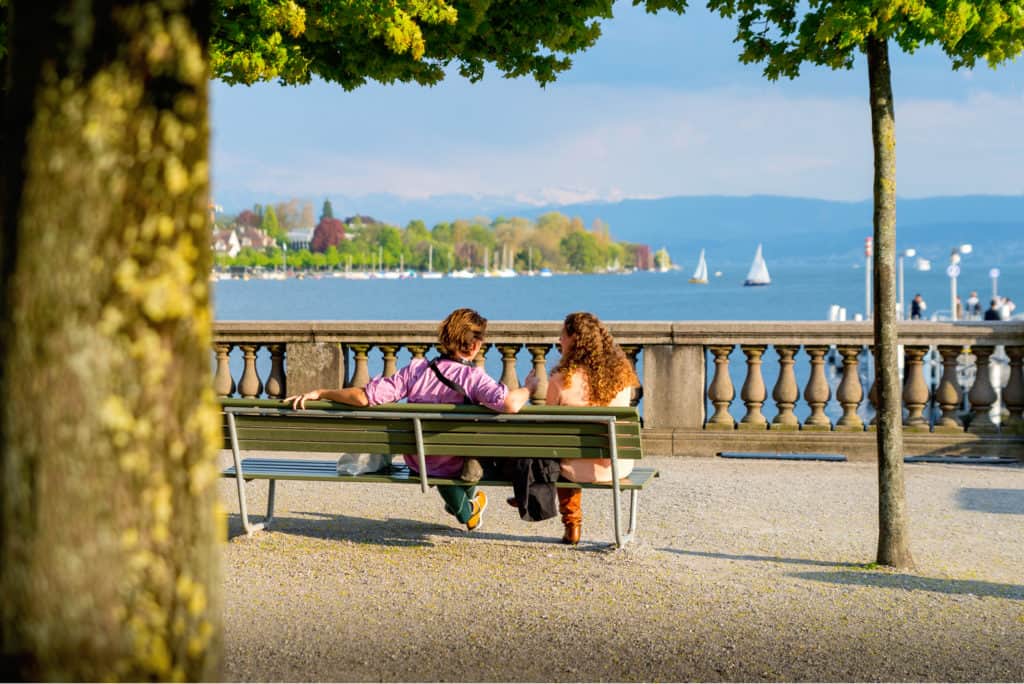
Walking the Lake Zurich Promenade
The vistas open up from Old Town as you pass from where the Limmat river enters Lake Zurich. There is an extensive series of lakeside promenades and gardens tailor made for getting in some walking while enjoying the scenery. Lake Promenade passes by colorful lakeside houses, shops, and restaurants, and is an invigorating way to get some exercise while thrilling to the wonderful vistas of the city’s skyline, expansive lake views, and snow-capped mountains in the background.
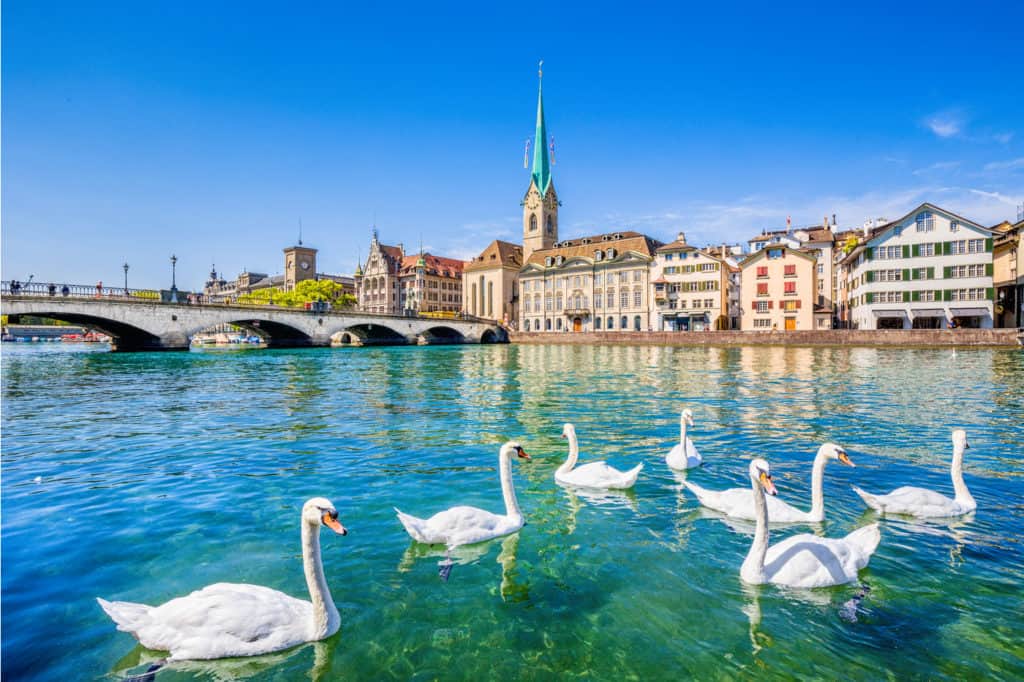
Strolling the banks of the Limmat
Walking the riverside promenades of the Limmat is another great way to take in the beautiful scenery. The Limmat cuts through the heart of Old Town and walks along its banks offer different perspectives of the town. You’re likely to spots swans and ducks, and swimmers and kayakers enjoying the water in the warmer months.
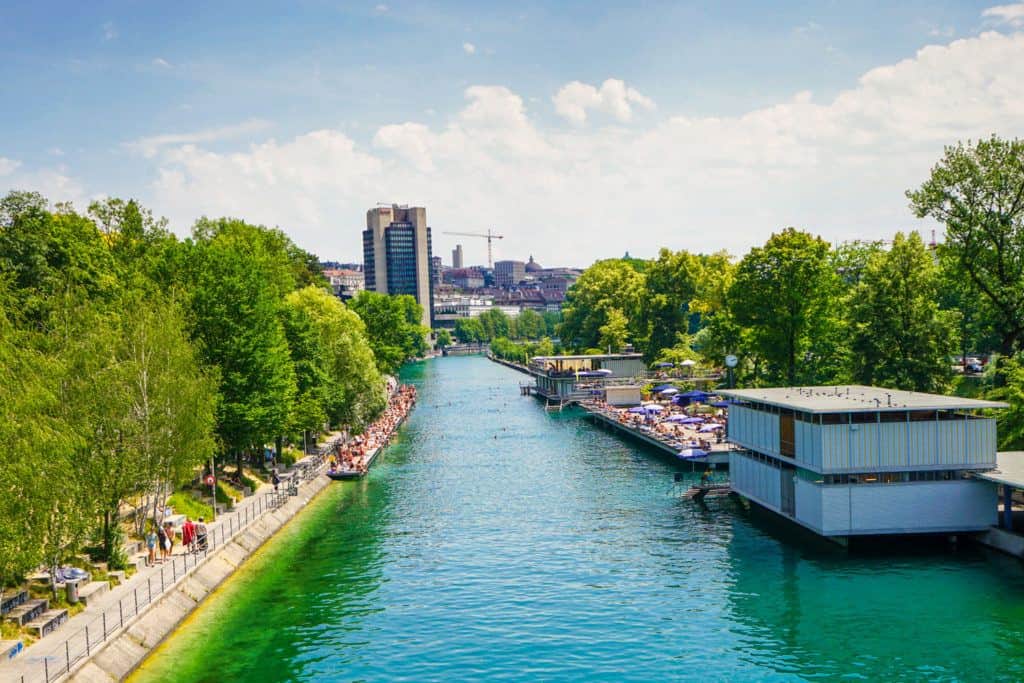
Swimming in the Lake or River
With such an abundance of water, it’s no wonder that locals and visitors alike enjoy swimming in the admittedly chilly waters of the Limmat River or Lake Zurich. There are many places to swim, including bathhouses with changing areas, beaches, and grassy areas to lay out in the sun before and after your swim.
One favorite location is the Flussbad Oberer Letten, an attractive riverfront swimming area on the Limmat that has a swimming channel, diving platform, sun terrace, volleyball courts and restaurant to relax and enjoy the scenic setting. And there is free entrance!
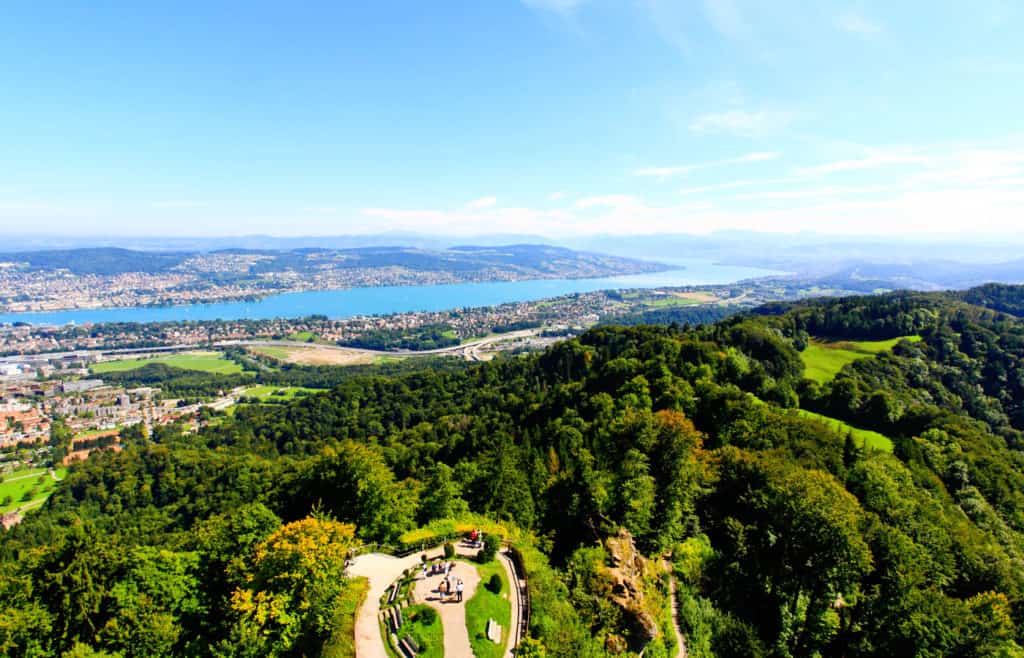
Climbing Uetliberg Mountain
Take an easy jaunt outside of the city to get into the mountains for some outdoor activities. At 2,850 feet above sea level, Uetliberg rises over the rooftops of Zürich. Go here for some great views over the city and Lake Zurich. There are hiking and biking trails, and in winter you can go sledding!
Trams leave frequently from Zurich’s train station for the 30-minute ride to Uetliberg. From here, you can take walking trails to the summit. It’s about a ten-minute uphill walk to the viewing area and the Uto Kulm restaurant.
Another hiking option is to take the mountain’s Path of the Planets, which was created to illustrate the distances between the planets in the solar system. The trail takes about two hours and stretches between Uetliberg and Felsenegg mountains.
Take a Thermal Bath
Zurich sits on top of mineral springs, so a fun and relaxing thing to do is soaking in a thermal bath. Hurlimannbad & Spa offers options ranging from bathing in the cellar of a 100-year-old brewery with vaulted stone walls or on its rooftop pool with lovely views of the Zurich skyline.
Walking Distinctive Neighborhoods
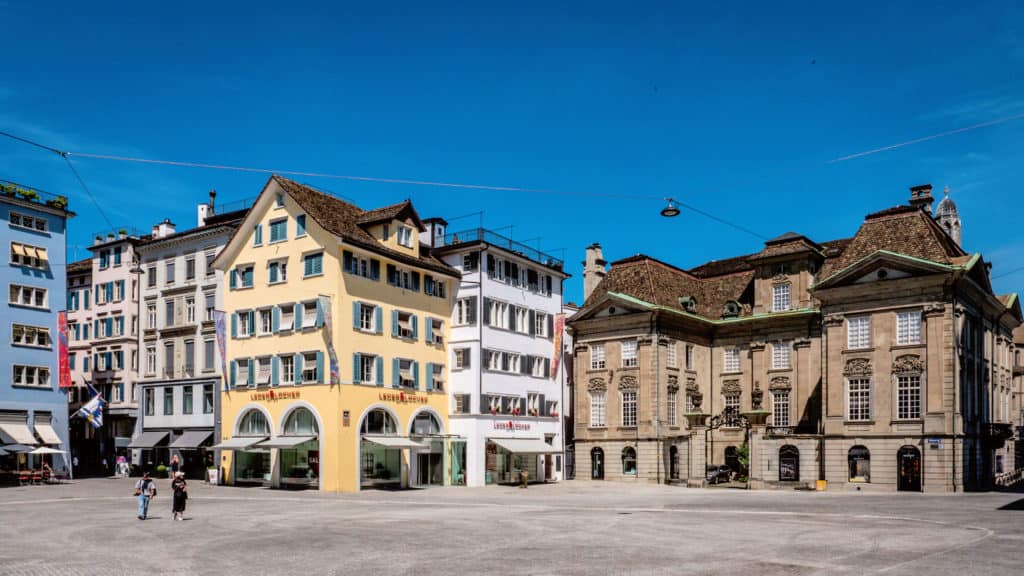
Old Town
Zurich’s Old Town is the medieval, historic part of town. This is the most atmospheric part of the city, and where many of its top attractions are. This is my favorite section of Zurich, and you’ll find yourself wanting to return for dining, shopping or just to bask in the ambiance as you stroll its cobblestoned alleys. Old Town is where you’ll find major sights like the Grossmünster, and its best museums including the Swiss National Museum and the Museum of Art.
The Old Town is very picturesque, and you’ll find yourself surrounded by buildings and churches that are hundreds of years old. The narrow streets house shops and galleries on both sides of the Limmat River that are fun to peruse. The river divides Old Town in two, with notable landmarks being the Lindenhof on the west bank and the Rathaus or Town Hall on the eastern side.
I think a great introduction would be to join in a guided walk so that you can learn the history of the Old Town while following an expert guide who knows the area inside and out. Consider this two-hour walking tour to introduce yourself to the highlights and history of the most picturesque and most historic part of the city. The tour cost is 25 CFH per adult.
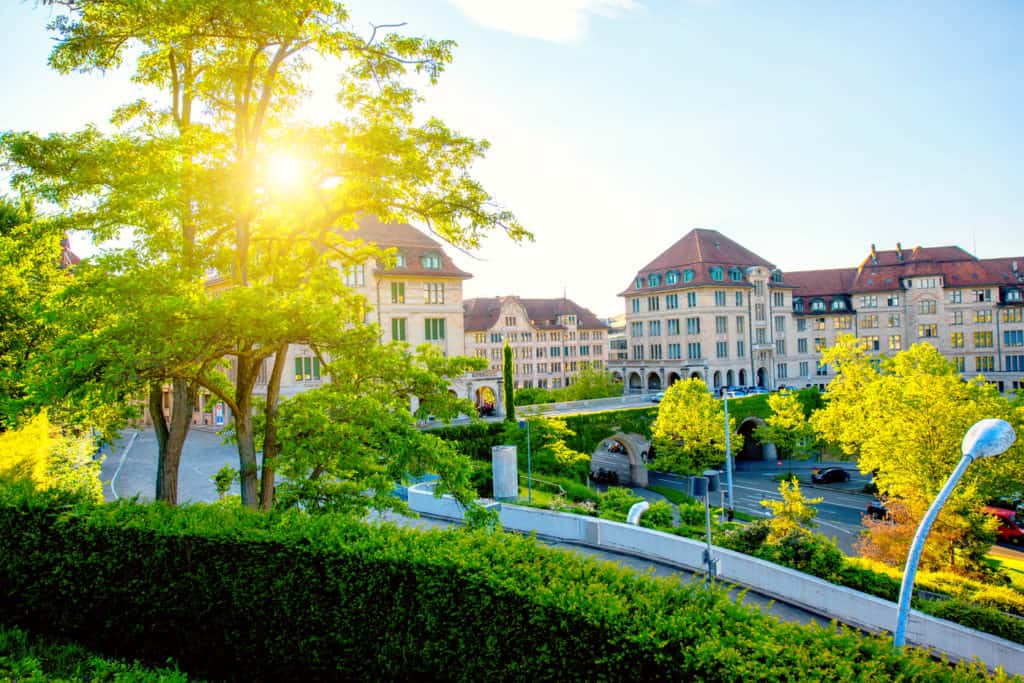
Lindenhof
Lindenhof is just a short walk up from Old Town but provides great views in a historic setting. In the 4th century a Roman fort stood here, and in the 9th century Charlemagne’s grandson built a royal palace as his residence. Now Lindenhof is a peaceful oasis in the heart of the city.
Take a break amongst the park’s Linden trees, benches, and giant chess sets where devotees engage in spirited matches. This is also a nice location for a picnic under the trees, taking in the views of the city and river at your feet.
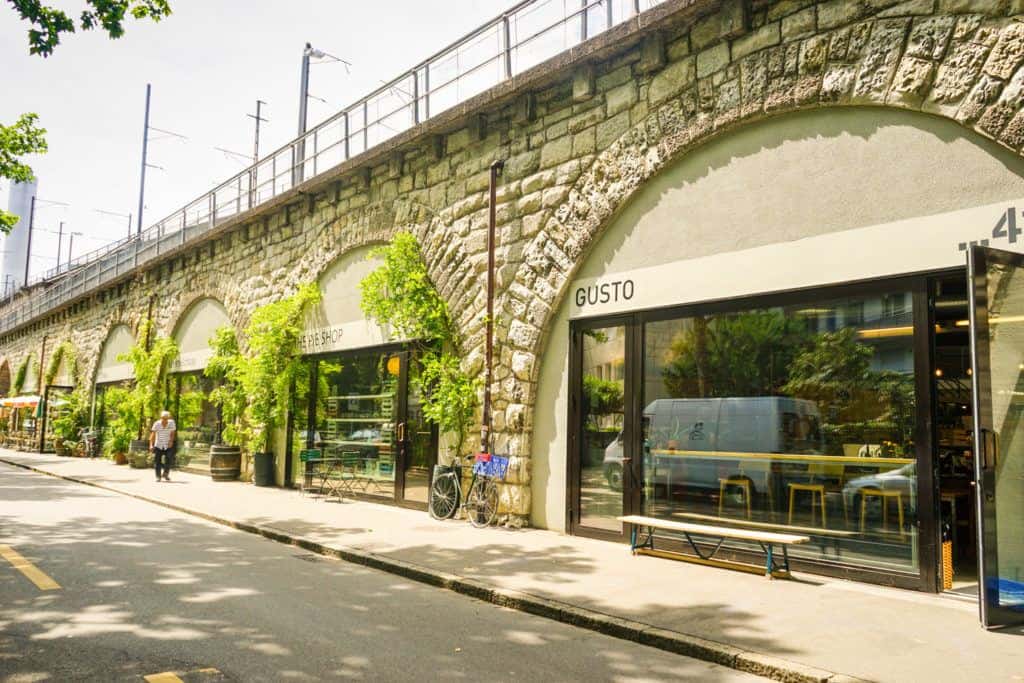
Zurich West
A more recent success story has been the redevelopment of the Zurich West district. What once was an abandoned industrial area of old factories and shipbuilding activities between the Limmat river and the railroad tracks has been reconfigured into a trendy arts district where food, culture, shopping, and modern architecture create an interesting mix.
Underneath the railway arches, you’ll now find a market hall where you can put together a picnic lunch, along with designer boutiques for shopping in an area known as Im Viadukt.
Also here is the Freitag Flagship Store, built in 2006. The store was constructed from rusted shipping containers piled beside the railroad tracks. Freitag has four levels of displays of its recycled merchandise, including its famous messenger bags along with other goods made from recycled materials like seat belts, bicycle tires and tarpaulins.
The cute little Polybahn takes you on a short ride up to a terrace in front of the main building of the Federal Institute of Technology where you can enjoy sweeping views of the city. Single ride tickets are 1.20 CFH.
Admiring Zurich’s Top Churches
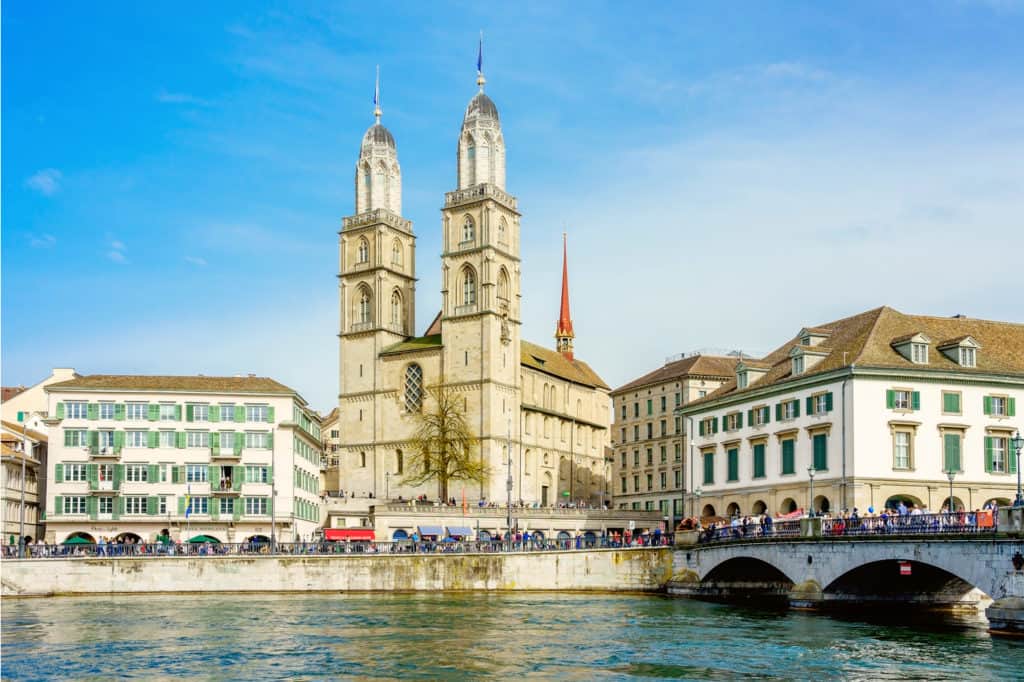
Grossmünster
You can’t miss the city’s iconic twin-towered landmark cathedral, founded by Charlemagne in the 9th century. According to legend, Charlemagne discovered the graves of the city’s patron saints Felix and Regula when his horse knelt down over the location, and he had a church built here as a monastery. The Reformation came to Zurich through the work of fiery preacher Huldrych Zwingli who spoke out against the Catholic Church in this church in the 16th century.
The stained-glass windows by Sigmar Polke and Augusto Giacometti, bronze doors by Otto Münch and the Reformation Museum in the cloister are some of the church’s highlights to look for. For great views overlooking the city, climb the southern tower, the Karlsturm. Admission is 5 CFH with an audio tour guide.
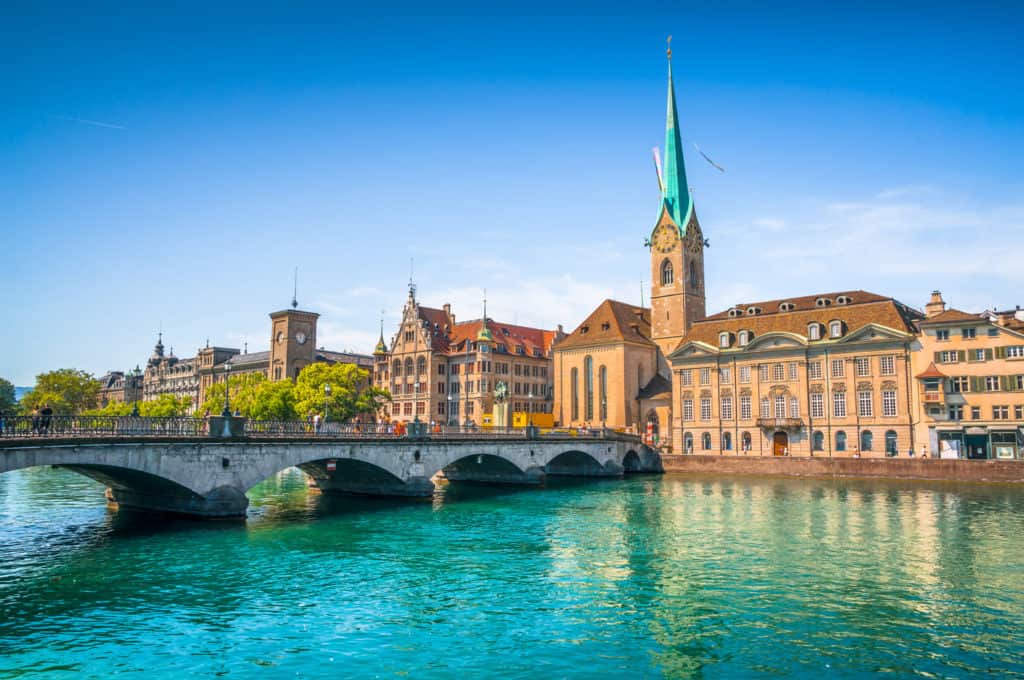
Fraumünster
One of Zurich’s landmark churches, the Fraumünster with its green steeple sits across the river from the Grossmünster in Old Town. The Fraumünster was built on the remains of a powerful ninth-century women’s abbey.
The church was founded by Emperor Ludwig, Charlemagne’s grandson, but its spire wasn’t added until 1732. The church’s greatest artistic treasures are the 20th-century stained-glass windows by artists Marc Chagall and Alberto Giacometti. Chagall’s set of five stained-glass windows in the chancel were createdin 1970 and illustrate biblical themes. Entrance fee is 5 CFH with an audio guide.

Church of St. Peter
The Old Town Church of St. Peter features the largest clock face in Europe, 8.7-meters that stretch across the top of its tower.
St. Peter has Romanesque and Gothic architecture and is extremely old, going back to the 8th century. The current church was the first constructed under Protestant rule in 1706.
Sample its Eclectic Museums
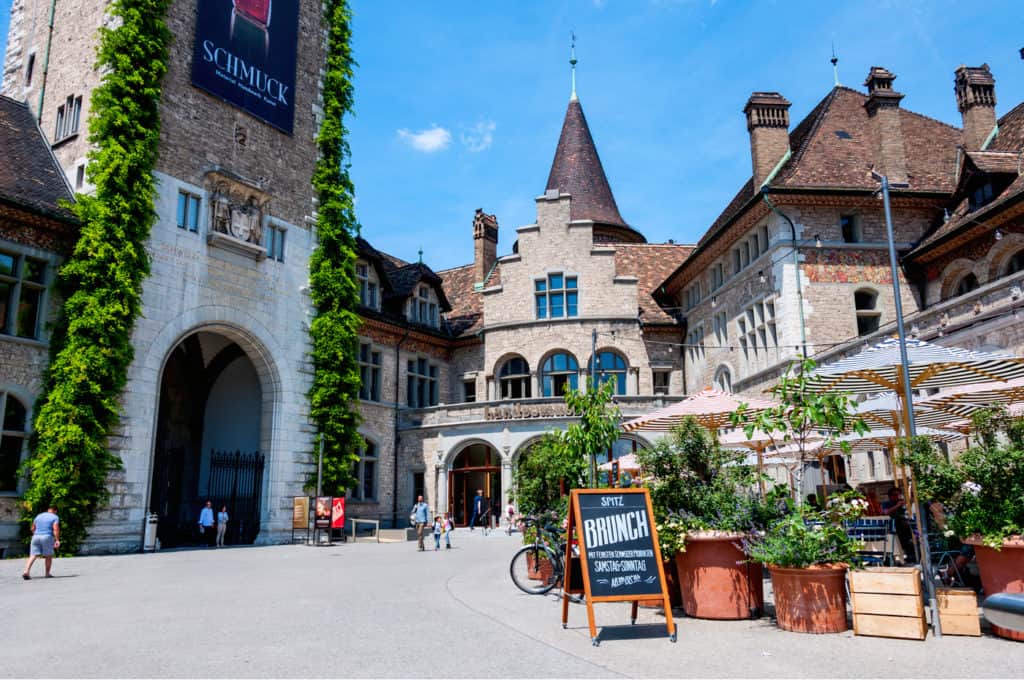
Swiss National Museum
What will capture your attention first about the Swiss National Museum is the building itself, residing in a historic, castle-like edifice near the main train station. The museum was built in 1898 by Gustav Gull and a modern addition was added in 2016 to expand the exhibition space.
The museum presents a comprehensive survey of Swiss art, history, and culture. Exhibits cover everything from medieval wall paintings and stained glass to weapons and collections of gold and silverwork. Period rooms display Swiss furniture and decorative arts. You could get lost in these immense collections, so I suggest planning a little in advance as to which of the eclectic collections interest you most, so that you can make the most of your time here. Admission costs 10 CFH.
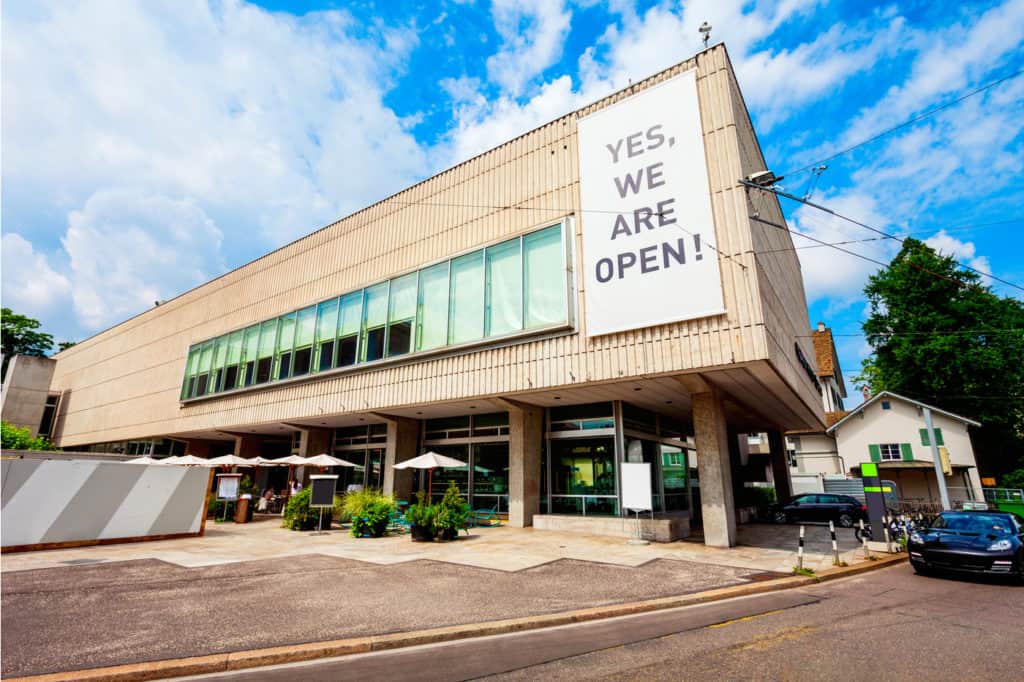
Museum of Art (Kunsthaus Zurich)
Zurich’s Art Museum has an excellent international collection of art, particularly strong in its Impressionist and Modern Art sections, making it one of the most interesting museum visits in the city.
Start with Rodin’s The Gates of Hell bronze sculpture at the entrance, and make your way to the upper floors to check out famous works like Vincent van Gogh’s Self Portrait with Bandaged Ear and Thatched Roofs by Avers, along with Andy Warhol’s Big Torn Campbell’s Soup Can. There are also works by such famous artists as Picasso, Chagall, Matisse, Cezanne (one of his Mont Saint-Victoire works is here) and Monet, including two of his water lily paintings.
There is also an interesting collection of Swiss artists, including Alberto Giacometti. The admission fee is CFH 23.
Museums for those with more time…
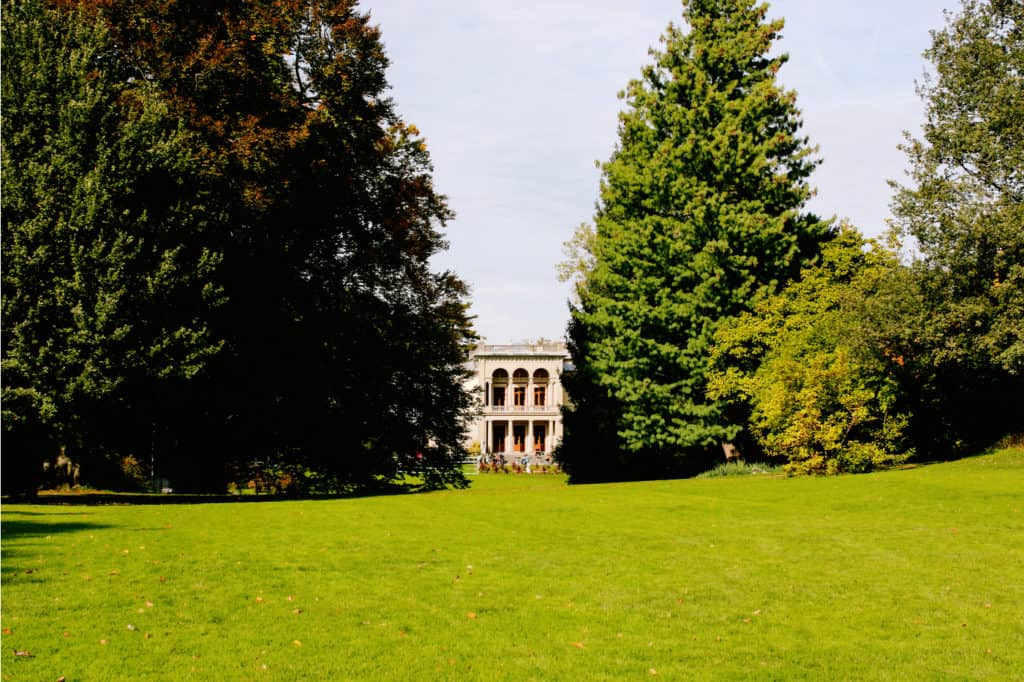
Rietberg Museum
Set in three 19th century villas in a leafy park and expanded through a modern underground extension with a green glass pavilion on top called the Emerald, the Rietberg Museum houses the country’s only collection of African, Asian, and ancient American art.
The Rietberg focuses on the arts and cultures of Asia, Africa, the Americas, and Oceania and owns over 20,000 art objects and over 30,000 ethnographic photographs. Public tours of the museum are conducted in German, but visitors can request a private tour in English or French. Adult admission is 14 CFH.
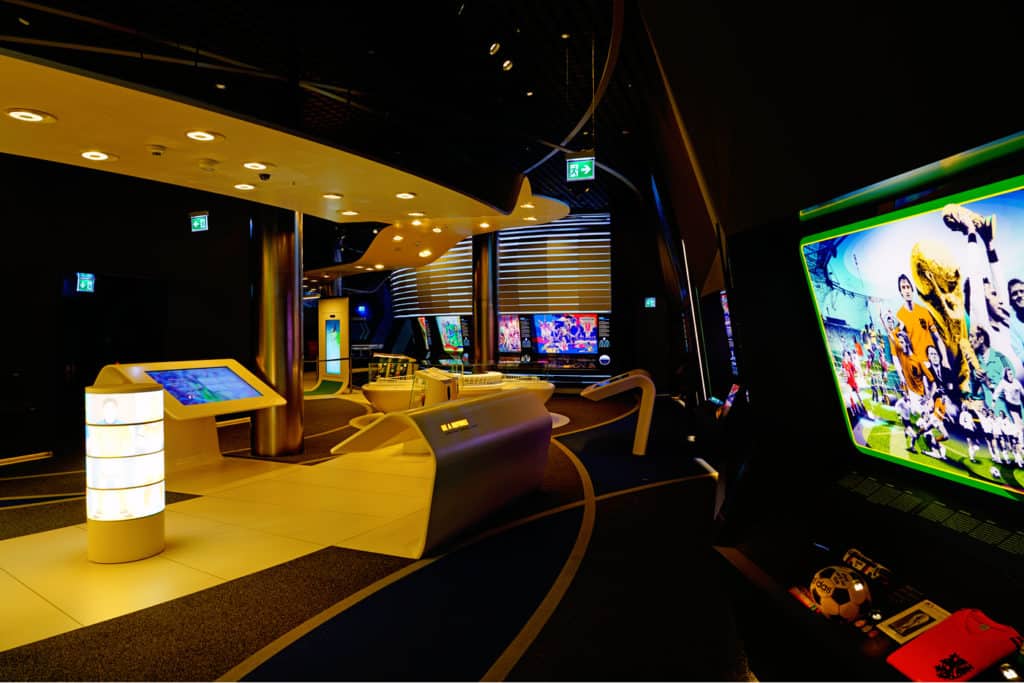
FIFA World Football Museum
Zurich is home to the FIFA World Football Museum, which opened in 2017. Fans of the game won’t want to miss this modern museum that traces the history of football, the governing body FIFA and every World Cup since the first was held in Uruguay in 1930.
Highlights include the original 1930 World Cup Trophy won by the host nation Uruguay. The museum features over 1,000 exhibits on football and contains a sports bar, restaurants, and a library. Adult admission is 24 CFH.
Beyer Clock Museum
In a country famed for its fine watches and timepieces, it stands to reason that there would be a place in Zurich to learn more about this art. In the lower level of the venerable Beyer watch shop on Bahnhofstrasse is a clock museum showcasing the history of clocks & watches.
Visitors are given an iPad with in-depth information about each timepiece, from sundials to hourglasses, grandfather clocks to wrist watches, with the oldest item going back to 1400 BC.
The admission fee is 10 CFH.
Check out Zurich’s Groundbreaking Architecture
Le Corbusier Pavilion
The brightly colored last work by the famed Swiss French architect, the Le Corbusier Pavilion stands on the shore of Lake Zurich at Seefeld. It is the only building he designed that was made completely of glass and steel. Work began in 1964 and was finished in 1967, two years after Le Corbusier’s death.
There is one temporary exhibition per year focused on his works. A small permanent exhibit by Swiss photographer Rene Burri focuses on the architect’s work and persona. Admission for adults is 12 CFH.
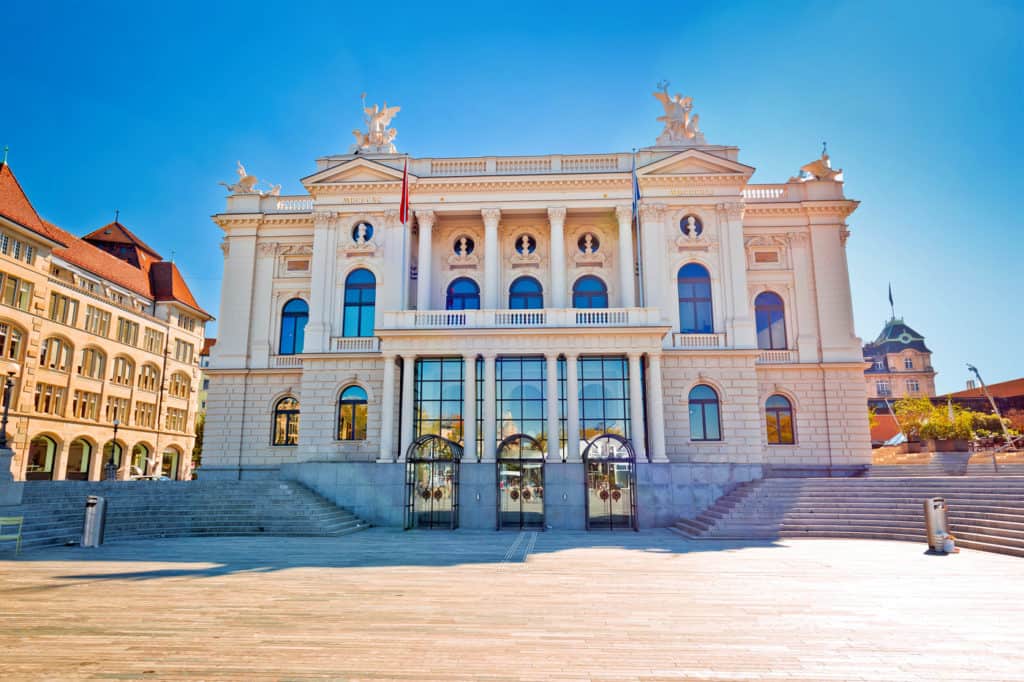
The Zurich Opera House
The Zurich Opera House opened in 1834 and is located lakeside at Sechseläutenplatz. After a fire consumed the original building, the current structure was built in 1891 and is an architectural work of art designed by Viennese architects Fellner & Helmer, who prolifically built theaters and opera houses in Europe in the late 19th and early 20th centuries. Zurich’s Opera House provides a program of classic and contemporary opera and ballet.
The Opera House received the 2014 prize for Best Opera Company at the International Opera Awards. Opera fans can get backstage on one of the 1.5 hour guided tours at a cost of 10 CFH per person. Normally tours are held in German, so check ahead if English language tours are available.
Parks and Gardens
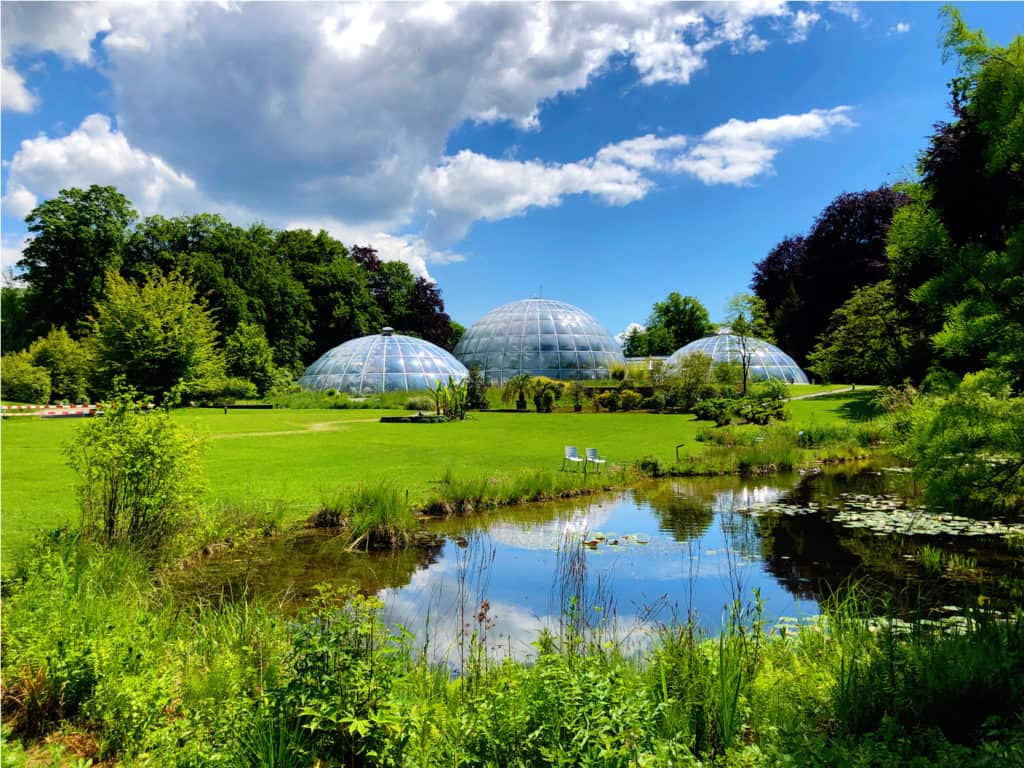
Zurich Botanical Gardens
For a pleasant dose of greenery, head along the east bank of the lake about 2.5 kilometers from the Grossmünster to visit the Botanical Gardens that are part of the University of Zurich. The most fascinating structures here are the series of biodomes, structures that provide warm savannah, tropical or subtropical environments for a wide range of plants to thrive year-round.
Thousands of plants make up the University’s botanical collection, which recreates a variety of ecosystems from alpine meadows to tropical rainforests. Entrance is free and a visit provides a nice respite in nature.
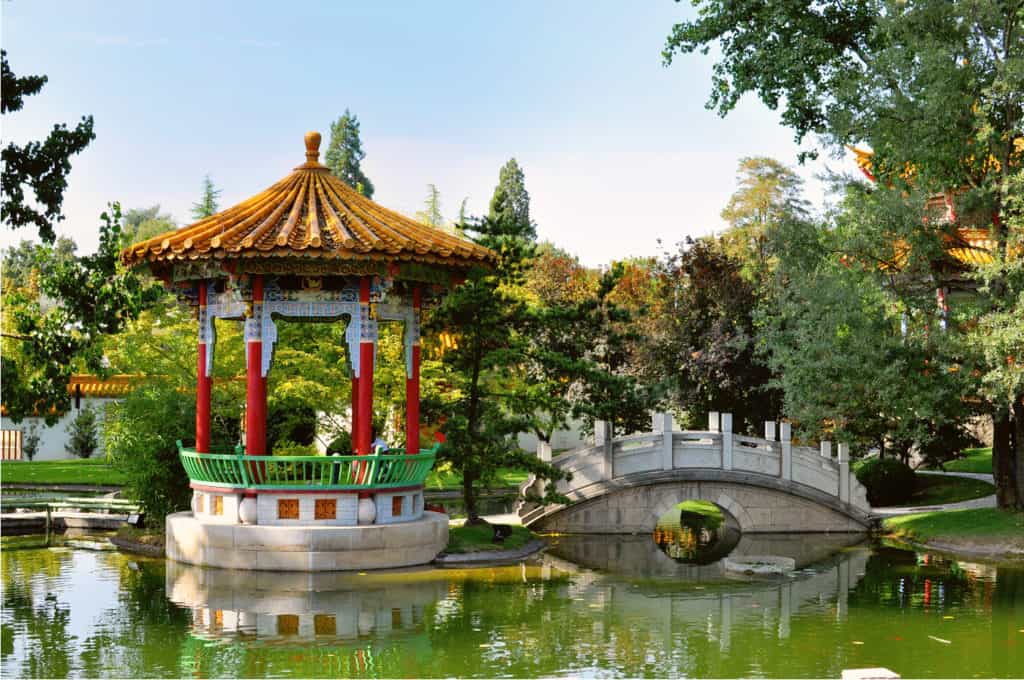
Chinese Garden
South of Old Town along the eastern banks of Lake Zurich in the Seefeld district lies the beautiful Chinese Garden, located near the Le Corbusier pavilion. The garden was given to Zurich as a gift in 1994 from the city’s Chinese partner town Kunming in thanks for the role the Swiss played in improving Kunming’s water facilities.
The temple garden is a lovely place to stroll, with pavilions, a small lake, an arched bridge, and well-kempt lawns and shrubs. The garden follows a theme of Three Friends of Winter and is planted with pine trees, bamboo, and plum trees which all withstand the cold of winter.
Sample Swiss Food and Drink
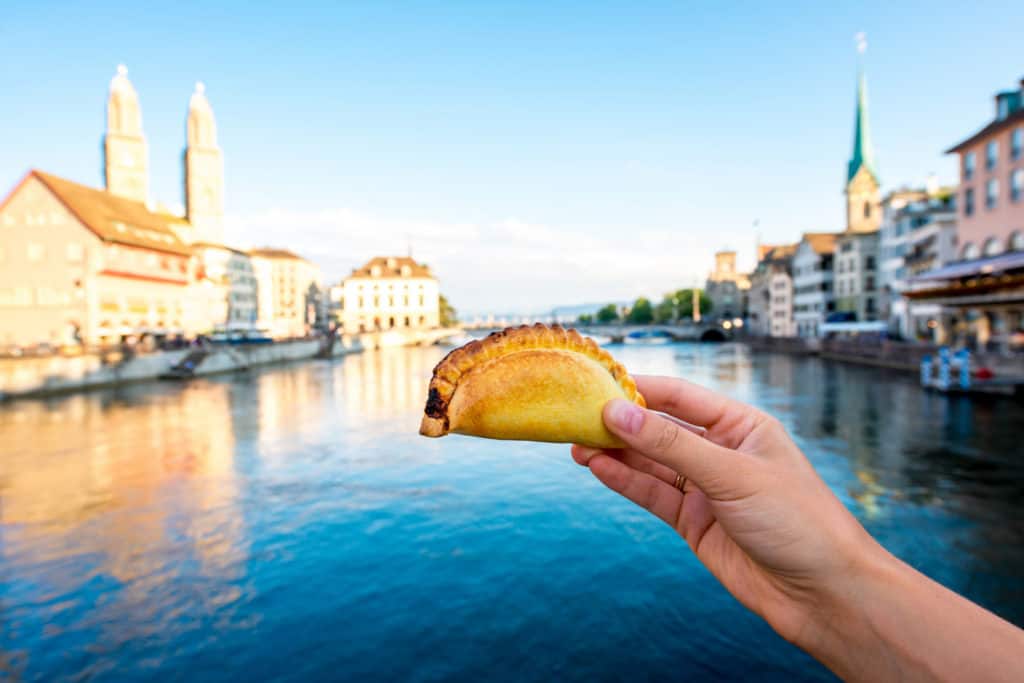
Zurich Food Tour
Explore the Zurich West district on this three-hour food tour where you’ll get to sample some of the best local treats while learning more about the transformation of the Zurich West area into one of the most dynamic areas of the city. The tour’s cost is 85 CFH per person.
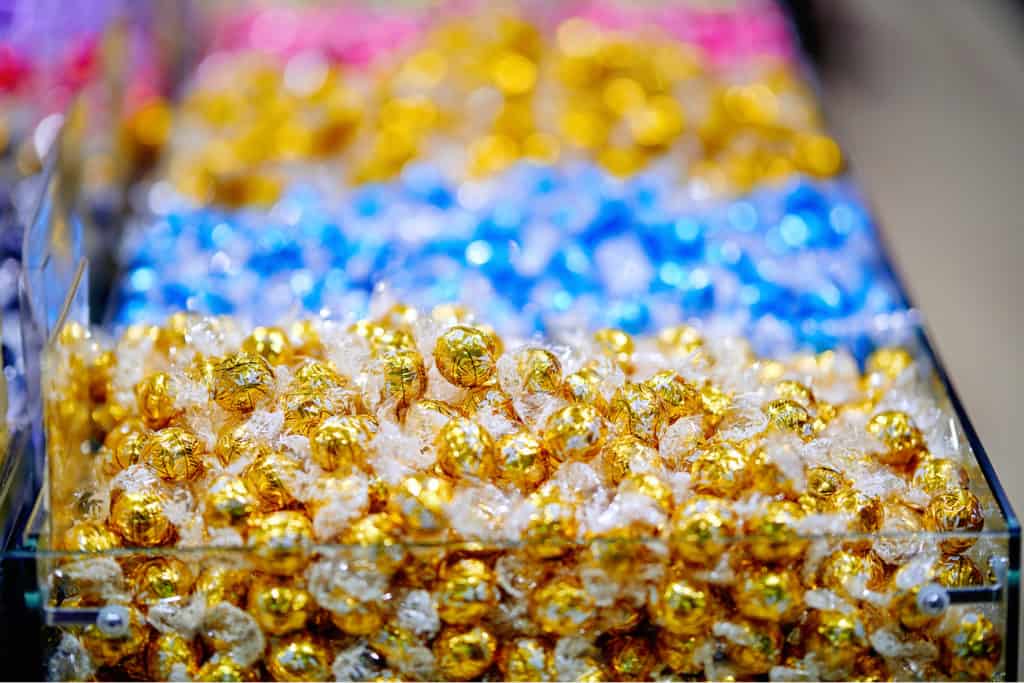
Lindt Home of Chocolate
One of the most famous Swiss foods is of course Swiss chocolate. Chocolate lovers will be in heaven at Lindt’s Home of Chocolate on the outskirts of Zurich, which offers a museum as well as the largest chocolate shop in the world. You’ll be awed by the nine-meter chocolate fountain!
The museum traces the history of chocolate from the time when Spanish explorers brought it back to Europe from the Americas to the pioneers of Swiss chocolate. You can learn how to make your own chocolate and take chocolate courses here too. The museum entrance fee is 10 CFH.
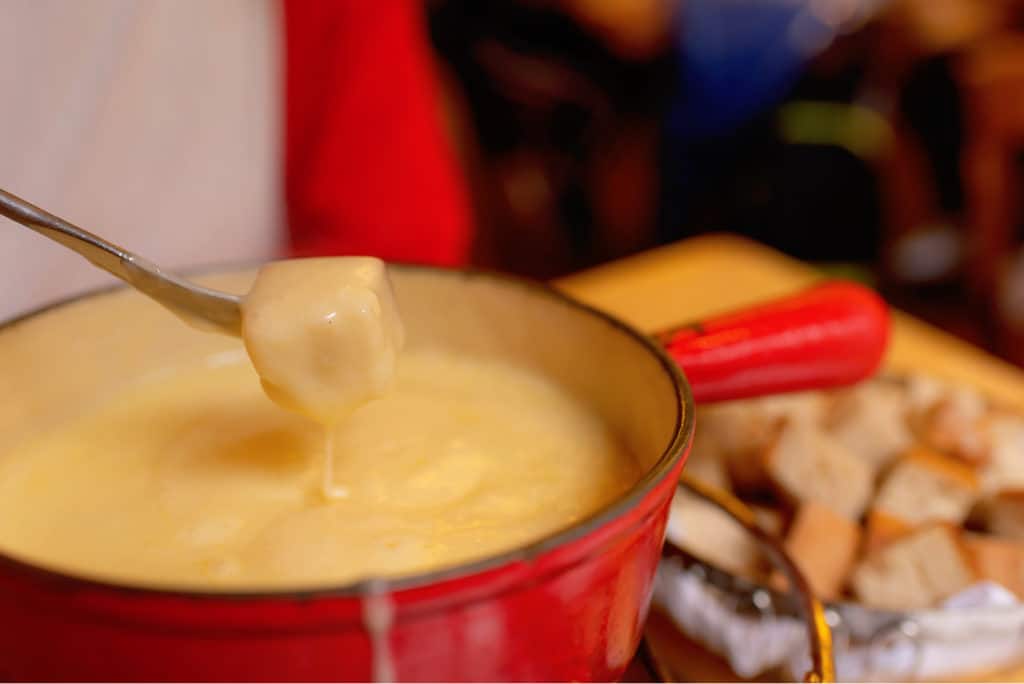
Eat Fondue and other Swiss Specialties
Another iconic dish to try would be fondue, that gooey meal of melted cheese with pieces of bread and small potatoes for dipping. The legendary history of the dish is said to have stemmed from when Swiss families needed to make a meal from stale bread and cheese in wintertime when fresh produce was unavailable.
Zurich doesn’t lack for places where you can have fondue, but one well-known restaurant that has been serving it for over 100 years is Le Dézaley with a prime location in the Niederdorf section of Old Town at the foot of the Grossmünster.
Other Swiss specialties to try are raclette, a dish of melted cheese typically served with thick-sliced bread, roasted potatoes, root vegetables, pickles and sliced, cured meat, as well as rösti (fried potatoes) and of course Wiener schnitzel and sausages. For another historical eatery head to Bahnhofstrasse near Paradeplatz to Zeughauskeller, where you can enjoy a welcoming, animated beer cellar environment. I had my first meal in the city here, drawn by the savory menu and the historic surroundings. The restaurant is housed in a former arsenal storehouse from 1487.
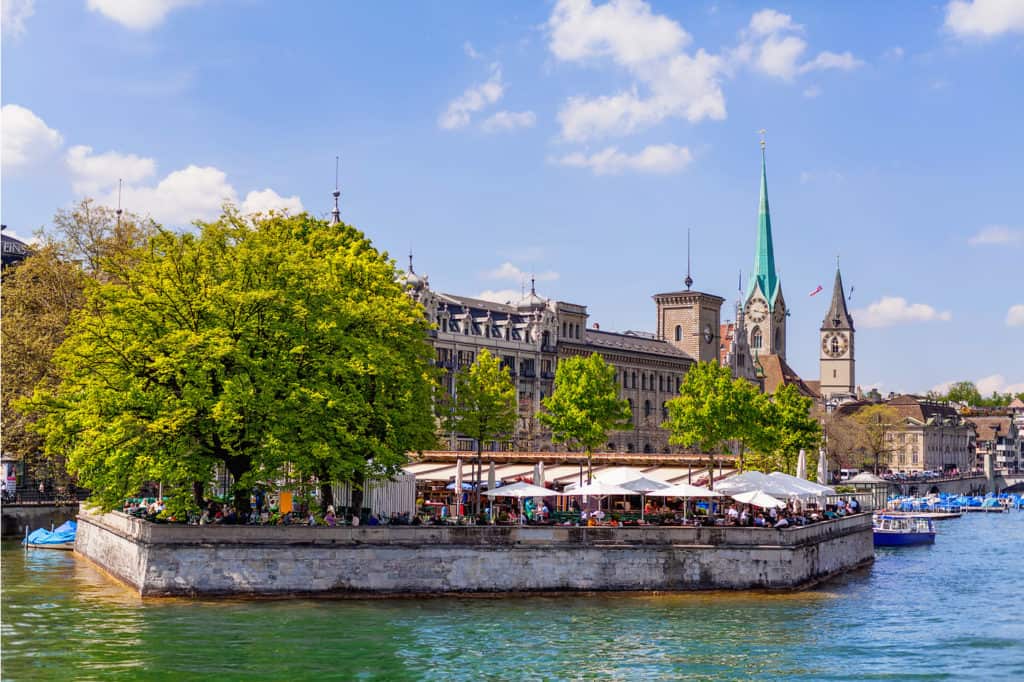
A Beer Garden in a beautiful setting
For great views, brews and local food, try Bauschänzli, an atmospheric riverside beer garden restaurant built atop 17th-century fortifications that jut into the middle of the Limmat River where it meets the lake. If you are here in the fall from early October to early November, you can join in here on Zürich’s month-long Oktoberfest celebration!
Zurich’s Best Shopping
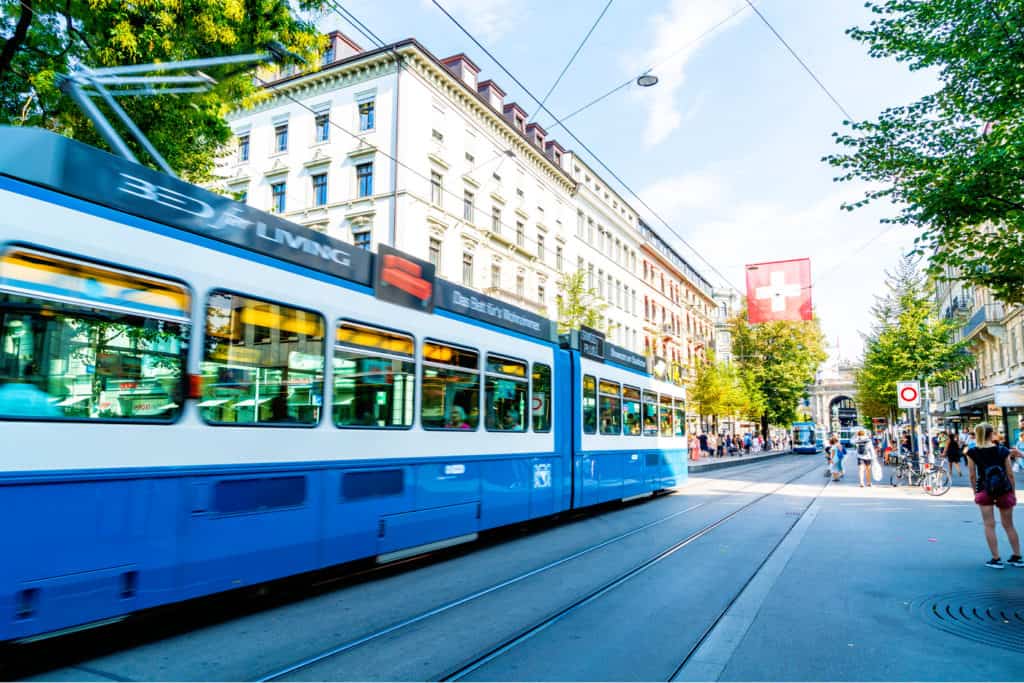
Bahnhofstrasse
The Bahnhofstrasse is one of the world’s most expensive shopping areas. Running 1.4 kilometers or just under a mile from the main train station (Bahnhof) to Lake Zurich, here you’ll find some of the most exclusive stores in the world. The most high-end shops cluster more towards the lake and Bürkliplatz. For me the window displays were enough, as many of the stores must buzz you in. But if you are in market for a fine Swiss watch, you’re in the right place!
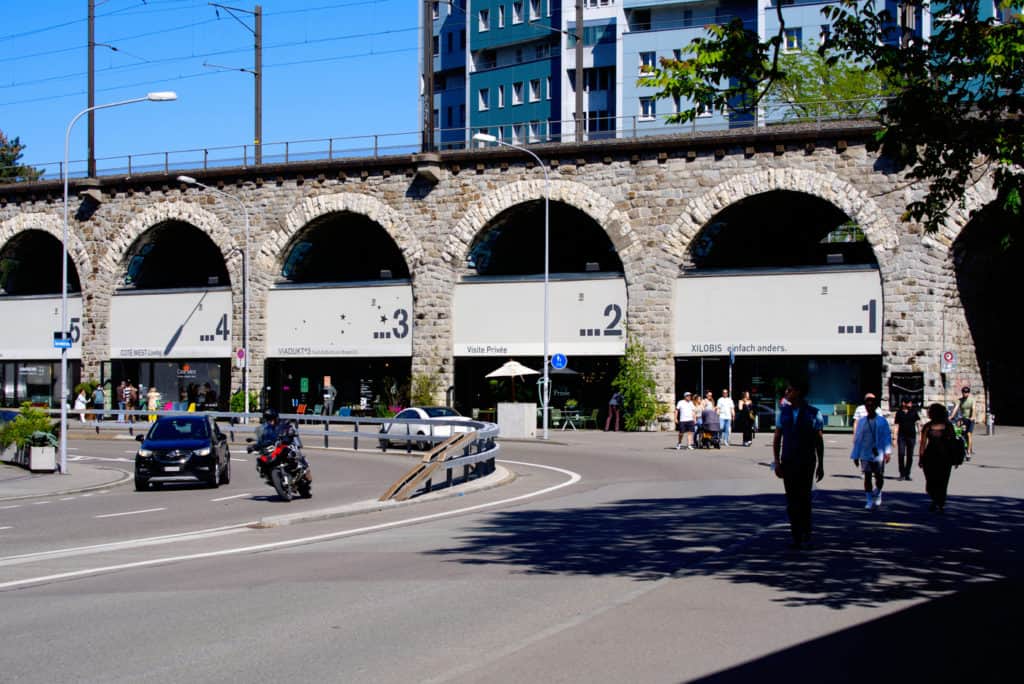
Zurich Viadukt
Back in the Zurich West district, the Zurich Viadukt is a fun shopping area created under an old railway viaduct that was built in 1894. Here under a 550 meter long stretch of arches are a collection of shops, galleries, and restaurants. There is also a Market Hall where you can gather food for a picnic on the grassy areas under the trees just across from the shops.
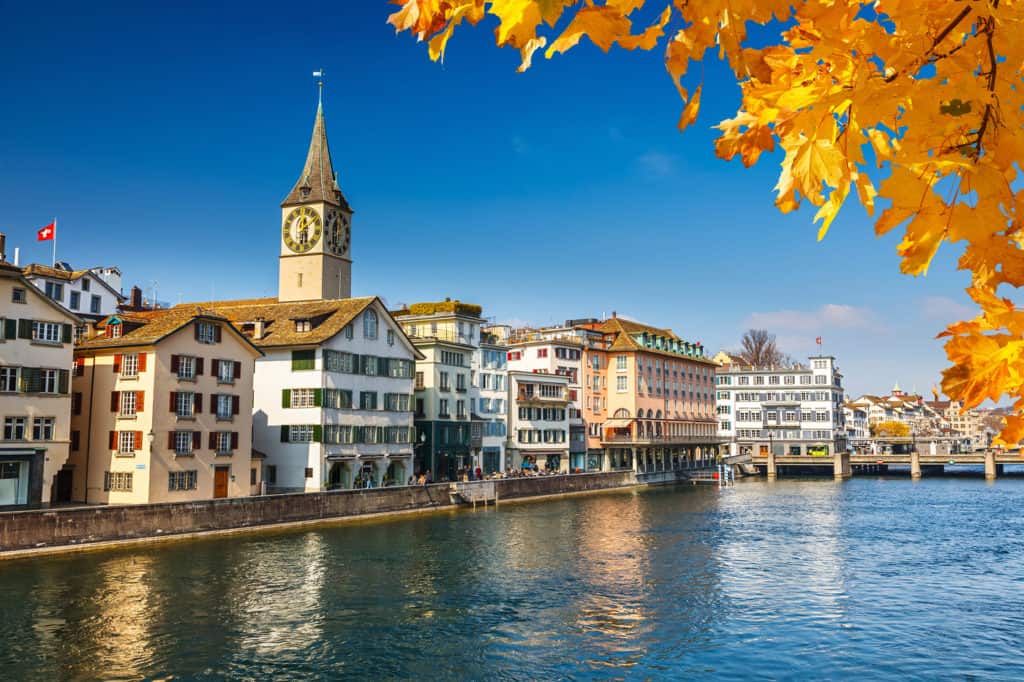
Limmatquai
Combine scenic strolls along the Limmat River with a shopping excursion by walking the Limmatqai. Of particular interest are the beautiful guild houses, many of which now house restaurants. Along the route look for Zurich’s Town Hall (Rathaus). Built between 1694 and 1698, it overhangs the river at the eastern end of the Town Hall bridge.
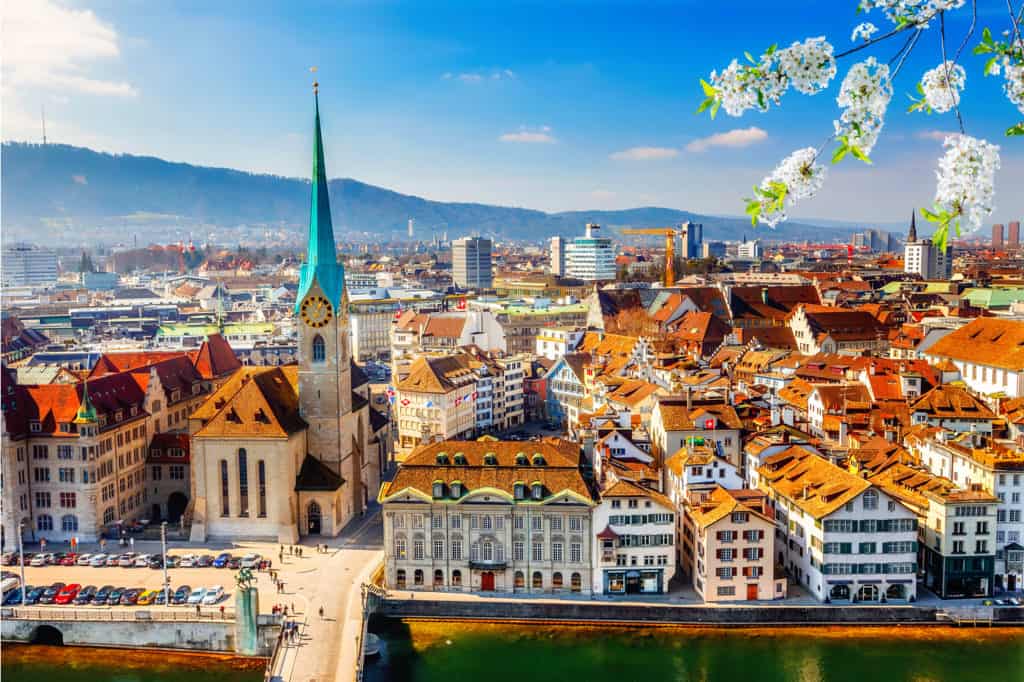
Zurich may not seem at first glance an obvious choice for a prime vacation destination. But it will begin to captivate you the minute you see its gorgeous lake and riverside setting with a Swiss mountain backdrop. Nothing beats getting outside to walk through and around Zurich.
The city has both a medieval historic core plus modern architecture in its suburbs, including the spectacularly revamped Zurich West neighborhood. Make sure to get out here for some shopping or dining.
The city abounds in cultural, historic, and artistic attractions, with first class museums such as the Kunsthaus Art Museum and Swiss National Museum, art-filled churches such as the Fraumünsterwith its Chagall stained-glass windows, a highly regarded Opera House, and high-end shopping along the Bahnhofstrasse.
Add to this all manner of outdoor activities from lake cruises to hikes in the mountains to idyllic rambles through Old Town and along the Lake Promenade, and you’ll be sold on Zurich’s charms. And the hearty meat and potatoes fare on offer in its atmospheric and historic restaurants will provide all the energy you need to continue your explorations of this dynamic Swiss capital!
Related Articles on Switzerland
🏦 15 Best Things to Do in Geneva, Switzerland
🥼 A Private Tour of CERN’s Large Hadron Collider

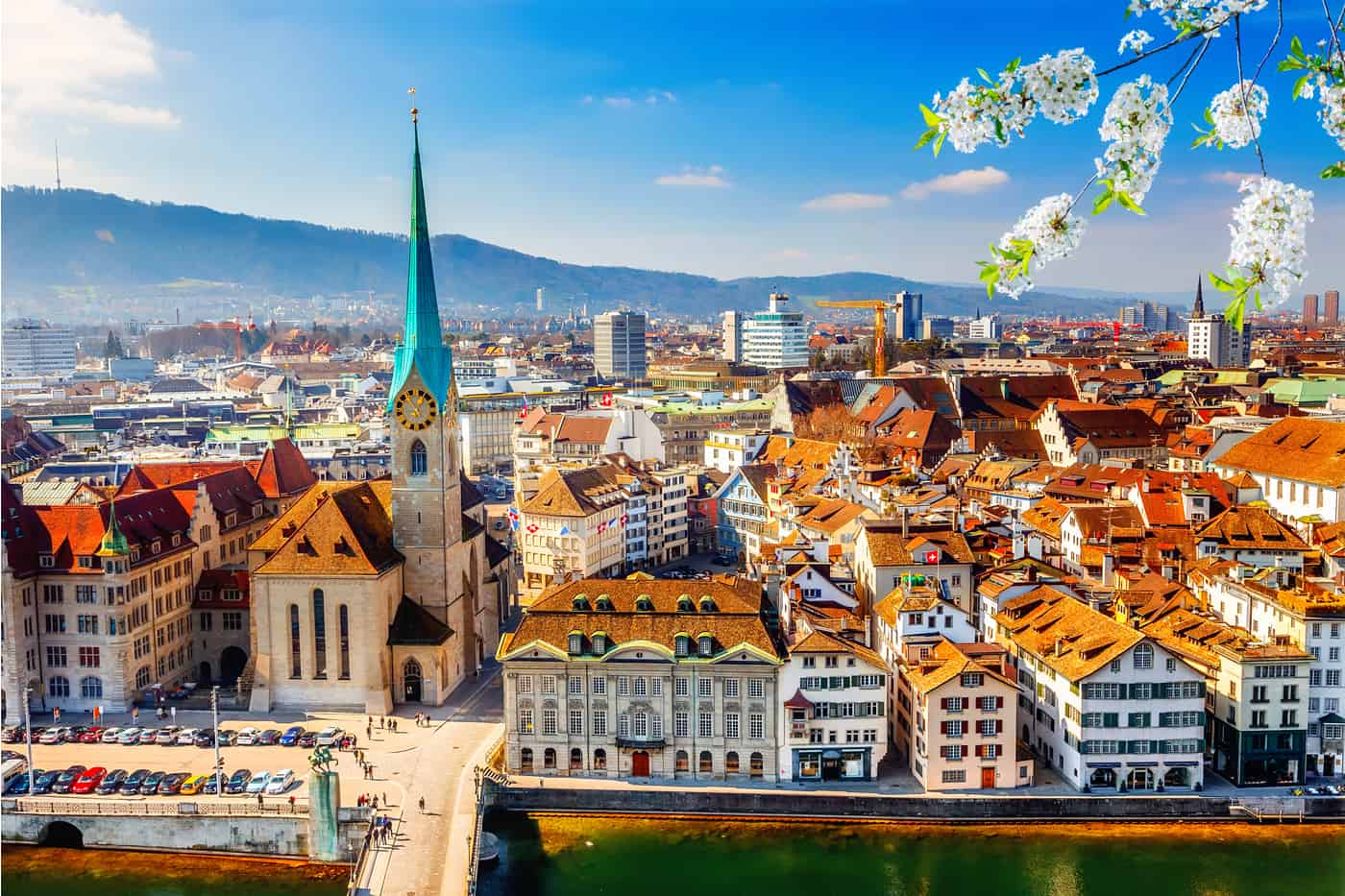



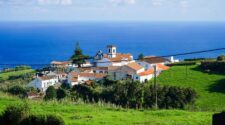
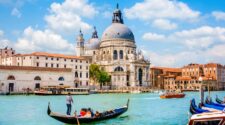

No Comment